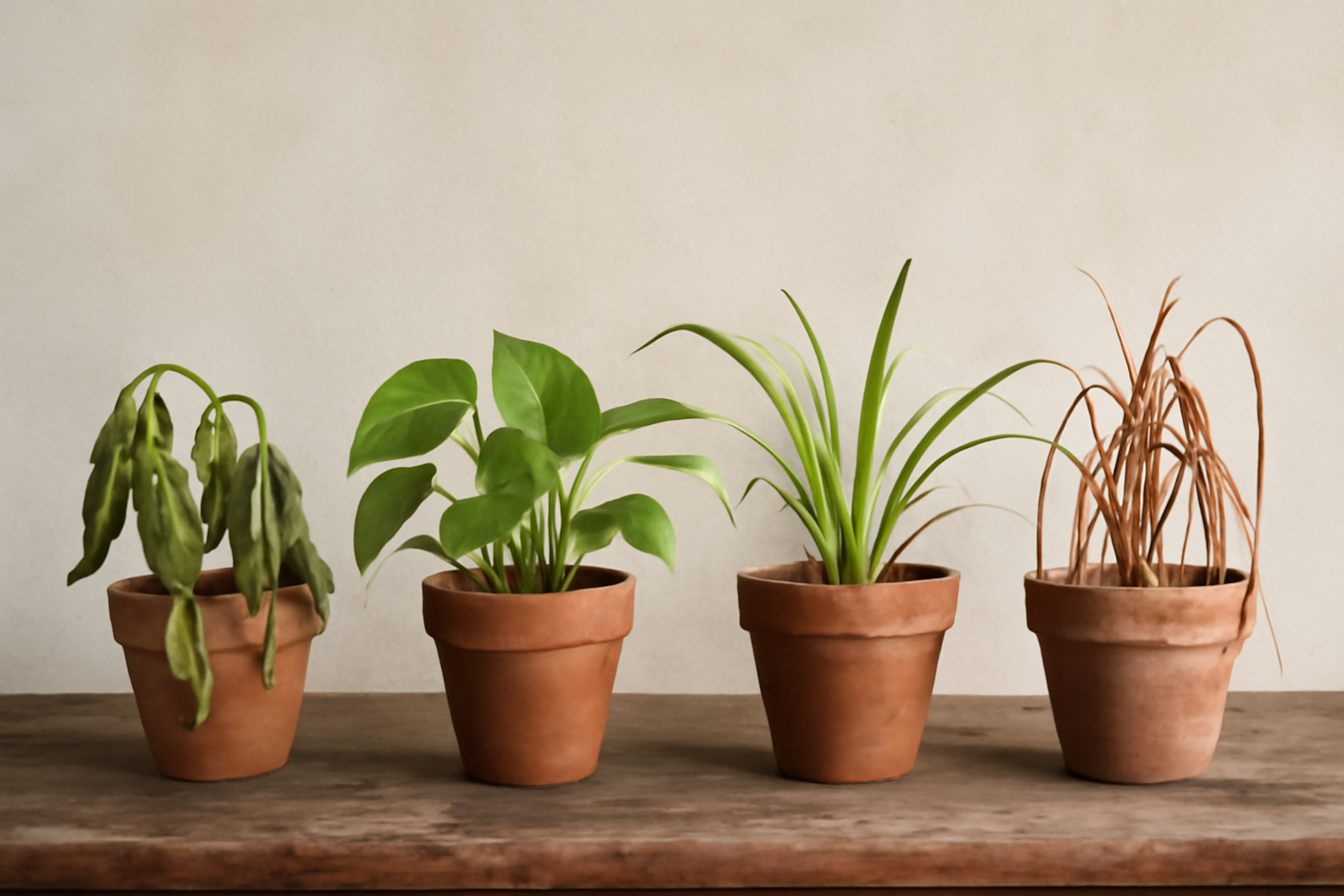Watering is often the first thing that comes to mind when caring for plants — but it’s also where most beginners go wrong. Overwatering and underwatering are two of the most common reasons why indoor plants struggle. Fortunately, plants usually send clear signals when their watering needs aren’t being met — and once you learn how to read them, you can build a thriving indoor garden with confidence.
In this guide, we’ll show you exactly how to recognize the signs your plant is too dry or too wet, how to check soil moisture accurately, and how to create a watering routine that works for your space and plant types.
Why Watering Is More Complex Than It Seems
Indoor plants don’t all follow the same rules. The correct watering schedule depends on:
- Type of plant
- Pot material and size
- Light exposure
- Humidity and temperature
- Soil composition
That’s why following a fixed “once-a-week” routine often leads to trouble. Instead, observe the plant and the soil, and respond to what they’re telling you.
Signs Your Plant Needs Water
Some plants are more dramatic than others, but almost all will give visible warning signs when they’re thirsty. Here’s what to watch for:
1. Drooping Leaves
One of the most noticeable signs. The plant looks limp, and leaves may hang down rather than standing upright.
Plants that droop dramatically:
- Peace lily
- Calathea
- Pothos
2. Dry, Crisp Leaf Edges
Leaf tips may turn brown and feel brittle. This can be a sign of dehydration, especially if the soil is also dry.
3. Soil Pulling Away From the Pot
If the soil is very dry, it contracts and pulls away from the sides of the pot — a clear sign it’s overdue for watering.
4. Slow or Stunted Growth
A plant that’s consistently underwatered won’t grow well and may remain the same size for weeks.
5. Leaf Curling
Some plants curl their leaves inward to conserve moisture.
Signs of Overwatering (Too Much Water)
Believe it or not, overwatering is even more common indoors than underwatering — especially in low-light spaces where soil dries slowly.
1. Yellowing Leaves
This is a classic sign of too much water, especially if the yellow leaves are also soft or falling off easily.
2. Mushy Stems or Base
If the lower part of the plant feels soft or squishy, rot may have started due to excess moisture.
3. Mold or Fungus Gnats
Overwatered soil creates a breeding ground for fungi and pests like gnats.
4. Wilting (Even When Soil Is Wet)
Yes, a plant can wilt due to overwatering! The roots may be suffocating or rotting, preventing water absorption.
5. Consistently Wet Soil
If the soil is always damp and never dries out, it’s time to cut back on watering — or improve drainage.
How to Check Soil Moisture Like a Pro
Instead of guessing, try one of these reliable techniques to know exactly when to water:
1. Finger Test
Stick your finger about 2–3 cm (1 inch) into the soil:
- Dry? Time to water
- Moist? Wait a few more days
- Wet? Definitely don’t water
2. Wooden Stick or Chopstick Test
Insert a wooden skewer or chopstick into the soil. If it comes out clean, the soil is dry. If bits of damp soil stick to it, there’s still moisture.
3. Moisture Meter
This handy tool gives a numerical reading of moisture levels at root depth. Especially useful for large pots or thick soil.
4. Weight Test
Lift the pot — dry soil is much lighter than wet soil. This is a great trick for hanging baskets or plants in plastic pots.
How Different Plant Types Signal Water Stress
Each plant shows water needs in its own way. Here’s a quick cheat sheet:
| Plant Type | Underwatered Signs | Overwatered Signs |
|---|---|---|
| Succulents/Cacti | Wrinkled, soft leaves | Mushy base, rot, leaf drop |
| Tropical Plants | Droopy leaves, brown tips | Yellowing leaves, wilting |
| Ferns | Dry, crispy fronds | Browning and rotting fronds |
| Pothos/Philodendron | Leaf curling, dry soil | Yellow lower leaves, soggy soil |
| Peace Lily | Dramatic drooping when dry | Yellow leaves if overwatered |
How to Create a Watering Routine That Works
1. Group Plants by Needs
Keep high-need plants (like ferns or calatheas) together and low-need plants (like snake plants or succulents) separate. This helps you water more efficiently.
2. Use Consistent Tools
Watering with the same container helps you control amounts more accurately. Avoid pouring from random glasses or bottles.
3. Adjust by Season
Plants drink more in spring and summer. In fall and winter, reduce watering — growth slows and light is lower.
4. Check Weekly, Don’t Water Weekly
Every few days, check your plants, but only water the ones that actually need it.
What to Do When You Overwater by Accident
If you realize you’ve been too generous:
- Stop watering immediately
- Place the pot in a brighter spot
- Check for drainage holes and remove excess water if necessary
- Repot if needed: If the soil is soaked and roots look mushy, gently remove the plant, trim damaged roots, and replant in fresh, dry soil.
Final Thoughts: Listen to Your Plants
You don’t need a degree in botany to understand your plants — you just need to pay attention. Learn their natural behavior, check the soil regularly, and observe how they respond to care.
Once you get in sync with their watering needs, you’ll notice how much better they look, grow, and thrive. And you’ll feel more confident every time you pick up that watering can.
Happy growing!
